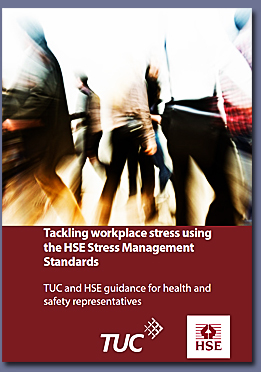The TUC and Health and Safety Executive (HSE) has this week published a new guide to help Trade Union Health and Safety Representatives tackle Workplace Stress and a pdf file copy is attached for the information of CWU Reps and Branches.
Work-related stress has been viewed as a major problem by trade unions since the 1980s. Trade Unions, including the CWU, have played a key role in ensuring that stress is now recognised as one of the main ill health concerns in the workplace.
 Writing in a letter to all CWU branches (LTB073/17) the Union's National Health, Safety & Environment Officer, Dave Joyce provides details and background to the new Stress tackling guide:
Writing in a letter to all CWU branches (LTB073/17) the Union's National Health, Safety & Environment Officer, Dave Joyce provides details and background to the new Stress tackling guide:
The need to tackle stress is also recognised in law. HSE’s position is that work-related stress should be treated as any other workplace hazard. Under the Health & Safety at Work etc., Act 1974 and the Management of Health and Safety at Work Regulations 1999, employers are obliged to undertake a risk assessment for health hazards at work – including stress – and to take action to control that risk. Unfortunately while many employers have accepted that stress is a major problem in their workplace, many others have no idea how to tackle it effectively.
HSE defines stress as “the adverse reaction people have to excessive pressure or other types of demand placed on them”. This definition is widely accepted and under this definition all stress is damaging. We all recognise that a certain degree of pressure is part and parcel of all work and helps to keep us motivated. However, stress can lead to physical or psychological ill health. HSE statistics show that stress is one of the top two causes of sickness absence (with musculoskeletal disorders) in Great Britain and research confirms that.
Last year 7 in 10 respondents to the TUC National Health and Safety Representatives survey, conducted across all UK Unions and Industries identified Stress as the top concern in their workplaces. As a result the TUC in conjunction with the HSE has issued this new guidance handbook, which will help Union Health and Safety Representatives and other Reps to work with employers to find practical solutions to work-related stress. The Main employers such as Royal Mail Group and BT Group have introduced Stress Risk Assessment Policies and Processes. The new TUC Guide will assist CWU Health and Safety Reps utilise those processes.
There is clear guidance available from the Health and Safety Executive (HSE), which will help organisations identify practical solutions to the problem. This is the Management Standards approach to Work-related Stress. If implemented properly, the Management Standards could significantly reduce levels of illness caused by work-related stress. That is why the TUC is working with the HSE to publish clear guidance for union health and safety representatives.
It is the TUC, HSE and CWU view that safety representatives should encourage their employer to implement the HSE Stress Management Standards in their organisation. There is a legal requirement on the employer to do a risk assessment that should include stress and, if stress is a problem in the workplace, the employer has to take steps to manage it. Employers have to have in place a suitable system for managing work-related stress and Unions and their Health and Safety Reps have a major part to play in ensuring that employers take their responsibilities, to tackle work-related stress, seriously. Dealing with stress at work highlights the fact that health and safety is not divorced from the rest of the union’s work activity.
The TUC/HSE guide is based on the HSE ‘Stress Management Standards’ in handling stress. It breaks down the causes of work-related stress into six key areas:
- Demands: issues like workload, work pattern and environment
- Control: how much say someone has over the way in which they work
- Support: available resources, line management and colleagues
- Relationships: dealing with unacceptable behaviour and promoting positive working
- Role: if the person understands their role at work and does not have conflicting roles
- Change: how organisational change – large or small – is communicated.
 The Guidance handbook suggests that Trade Union Representatives should, through their Legal Rights to carry out Health and Safety Inspections, gather information on the current situation in the workplace and discuss with management the need to carry out a stress risk assessment in order to identify practical proposals for change that could make a real difference, such as tackling poor work culture and improving workplace working practices and conditions.
The Guidance handbook suggests that Trade Union Representatives should, through their Legal Rights to carry out Health and Safety Inspections, gather information on the current situation in the workplace and discuss with management the need to carry out a stress risk assessment in order to identify practical proposals for change that could make a real difference, such as tackling poor work culture and improving workplace working practices and conditions.
Workers are increasingly suffering from the effects of workplace stress as pressures of heavy workloads, long hours and low job security are taking hold across the UK. The Guidance emphasises the fact that it’s in no-one’s interest to have an overstretched, stressed out and anxious workforce, as staff are less productive and are more likely to take time off in such circumstances. The HSE Stress Management standards provide the best way of tackling the issue.
Unions and employers working together to invest in health and safety can result in a vast improvement in other aspects of industrial relations and a working environment in which work-related stress is managed properly. This new guide is designed to help union safety representatives encourage employers and managers to work with them to implement the HSE Management Standards approach to managing work-related stress. The Management Standards, and the approach were launched in 2004 following extensive development and piloting. They are an effective tool for assisting organisations to identify the causes of work-related stress and implement practical solutions to manage the risks. They are now the main standard in use in the UK.
The new guide:
- Gives a background to the problem of stress
- Outlines what the Management Standards are
- Says what you and your employer can do
- Explains the process
- Gives advice on how to build your knowledge
- Tells you where to go for additional information.
The HSE Stress Management Standards approach to work-related stress and the accompanying guidance and tools have been designed to assist employers in identifying causes of stress in the workplace and to develop and implement solutions to minimize the effects on workers. The TUC and affiliated unions welcomed this development as it gives real support to employers wishing to tackle stress at work. The standards also give health and safety enforcement officers a means of assessing whether an employer is failing to manage stress adequately.
The TUC and CWU believe that the application of the approach through agreed deployment arrangements provides the most effective way of dealing with stress and highlights the critical importance of involving unions and employees at every stage of the introduction of the process in developing management systems and preventative measures. If employers try to introduce them without proper consultation they are unlikely to be effective or supported by employees.
Union Health and Safety Representatives have an important role in the process of managing stress in the workplace and a key role to play in working with employers to tackle this problem and are an integral part of the communication between members and the employer and in encouraging members to take an active role in the internal stress risk assessment process where it is being properly used. Stress is preventable if workers have reasonable workloads, supportive managers and a workplace free from violence, bullying and harassment. Union Health and Safety Reps and other Reps also have a role in tackling the stigma of stress, anxiety and mental ill-health. People perceive stress as a weakness and this may contribute to underreporting.
Source: CWU/TUC/HSE